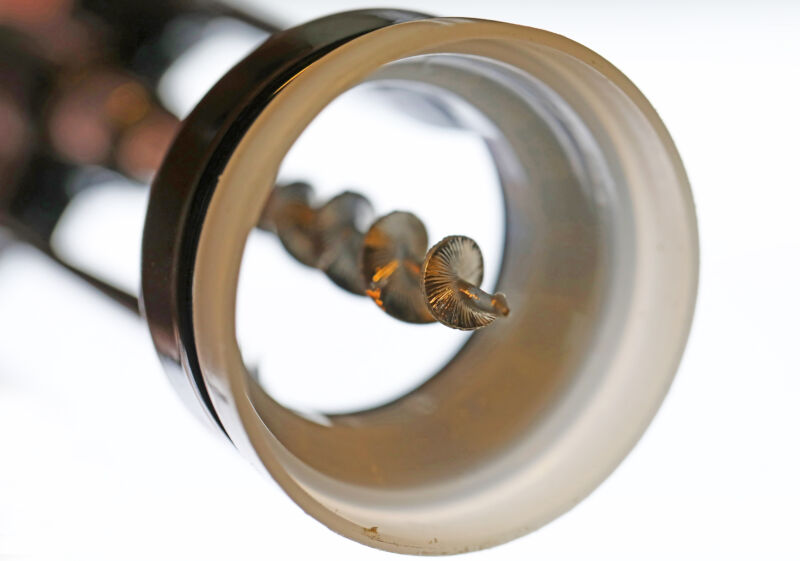
The modern world depends on good communication. If you were one of the few who didn’t believe that, the recent obsession with video conferences should have convinced you otherwise. The key for video is volume: huge streams of data facilitated by high-capacity optical-fiber communications networks.
It might surprise you to hear that, actually, optical communication is not very efficient. A recent paper shows off a laser that may allow the information density to be increased by using something called orbital angular momentum (OAM).
Low-bandwidth light
Before we get into the dizzying world of light that corkscrews its way through life, let’s see why light is used so inefficiently. An AM radio station might operate at a frequency of 500kHz and might use up to 5kHz of bandwidth, giving it a spectral efficiency of 1 percent. If we were to scale that up to optical frequencies, we should have a bandwidth of around 2THz, and you might expect data rates of 1Tb/s for a single wavelength.
But, a single wavelength of light is limited to something between 10Gb/s to 100Gb/s. To put that in perspective, my own Internet connection uses a significant fraction of one channel when operating at capacity.
There are more details about this inefficiency in the sidebar, but suffice to say that modern electronics are just not fast enough to modulate light very well. The alternative is to modulate many different properties of light so that we encode lots of information even though the modulation is slow. At present, we modulate phase and amplitude, but these are properties that change continuously, so it is easy to mistake one phase for another that is close by. A property of light that came in discrete states might be better.
This is where OAM can play a role. The easiest way to think about OAM is to imagine that the light travels in a kind of corkscrew pattern. A bit can be defined by whether it corkscrews clockwise or anti-clockwise. Along with the rotational direction, the tightness of the corkscrew can also vary. In principle, light can take on an infinite number of OAM states.
But it doesn't end there. Although there are infinite number of states, they are discrete and separate from each other—you cannot describe one OAM state by a mixture of other OAM states. This means that it is more difficult to mistake one OAM state for another (unlike the errors we make when comparing to two brightnesses). If we could but change (and detect) the OAM state of light rapidly, we would have a very efficient way to send data.
A corkscrew laser
The problem is rapidly switching between OAM states, which we don't currently know how to do. This is where the latest research comes in. The researchers constructed a ring-shaped waveguide for light. Around the inside of the ring, they placed a series of ridges. These ridges scatter the light out of the ring, so it emits light upwards in the plane of the ring. If you imagine the ring being on your finger, light circulates around your finger in the ring, but is emitted along the direction of your finger. Depending on the direction that the light circulates (and a number of other factors), the emitted light will have OAM. Simply switching the direction of light gives you access to two OAM states.
The researchers noted that, if the ring had a system that amplified the light, the laser light it emitted would have an OAM state that depended on how the laser was excited.
Imagine that the ring is setup to emit the +2 (second state clockwise) and -2 (second state anti-clockwise) OAM states. When excited from the clockwise direction, you get +2 and excited; from the anti-clockwise direction, you get -2. However, if the two excitations balance, you get the 0th state (so, no OAM). If the balance is shifted, so one excitation is a little higher than the other, you could get the +1 state (or the -1 state). In other words, by switching the exciting amplitudes, all the states from +2 to -2 can be generated.
The researchers demonstrated this—it does work. But we are not to the point where this can be expected in a communications system very soon. Rapid switching is possible in principle (the laser should be able to switch in picoseconds), but that still has to be done in practice. Then, we have to demonstrate that we can transport and detect OAM states efficiently.
Yes, the states themselves are all discrete, but that does not mean the light we produce or detect is always in a pure state, as the laser and the intervening optics could result in a mixture of OAM states. To decode the data, a decision has to be made about the intended state. That means that errors will be inevitable. And that means that, while factors of two to four are almost certain to work, I'm less certain about factors of 10 to 100. Nevertheless, this is a very cool piece of work.
Science, 2020, DOI: 10.1126/science.aba8996 (About DOIs)
"light" - Google News
May 17, 2020 at 09:00PM
https://ift.tt/365BZzn
Corkscrew light promises higher optical-communication data rates - Ars Technica
"light" - Google News
https://ift.tt/2Wm8QLw
https://ift.tt/2Stbv5k
Bagikan Berita Ini















0 Response to "Corkscrew light promises higher optical-communication data rates - Ars Technica"
Post a Comment